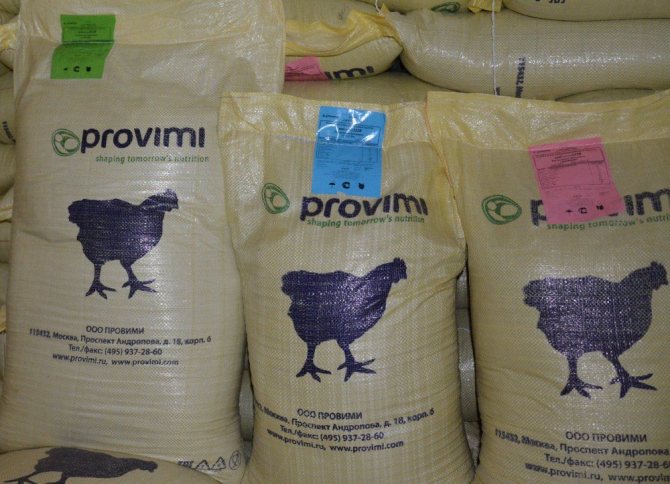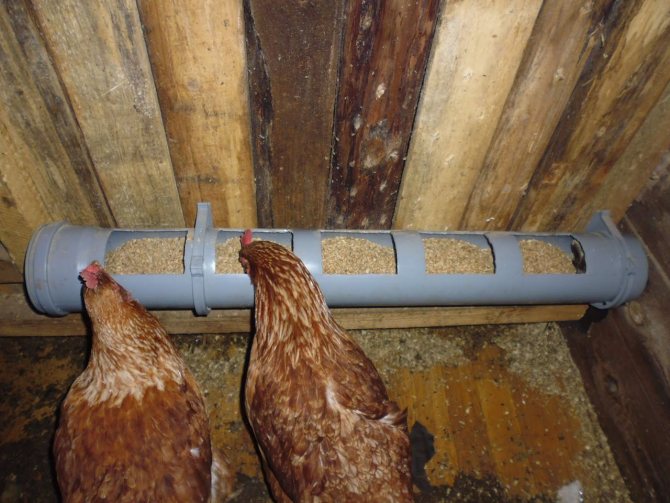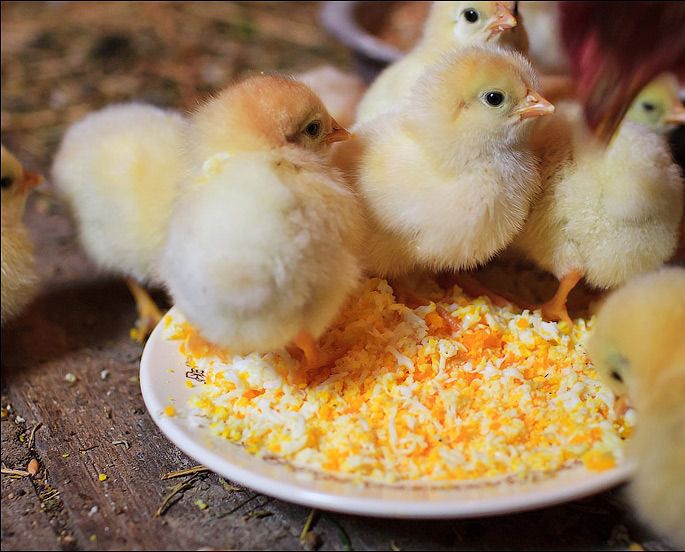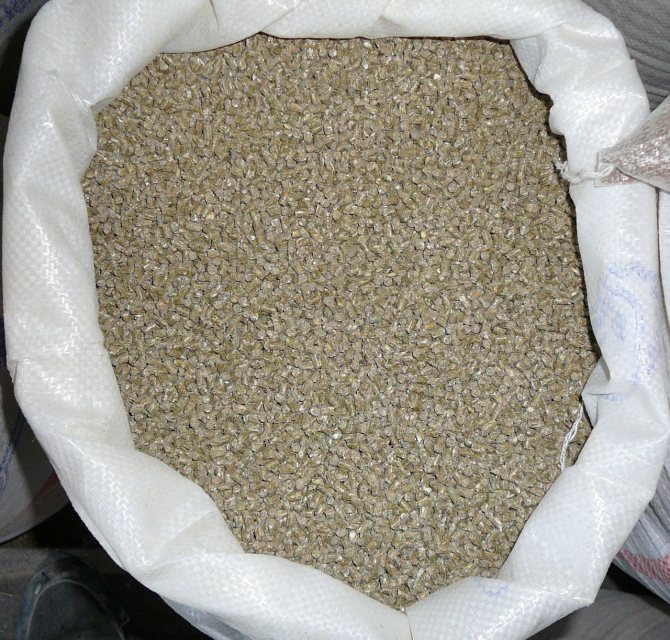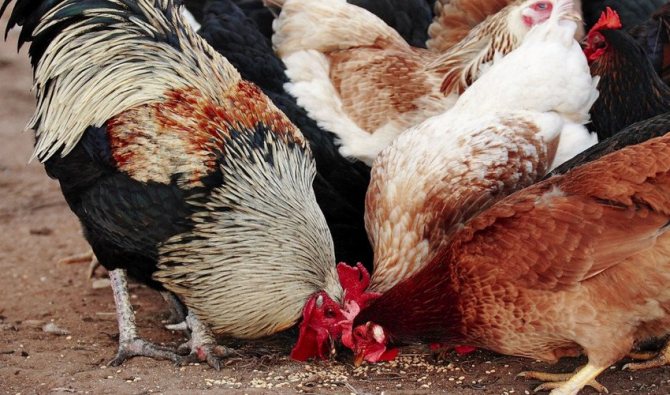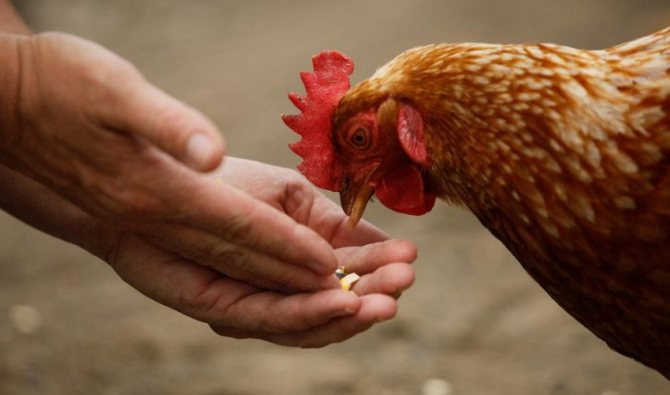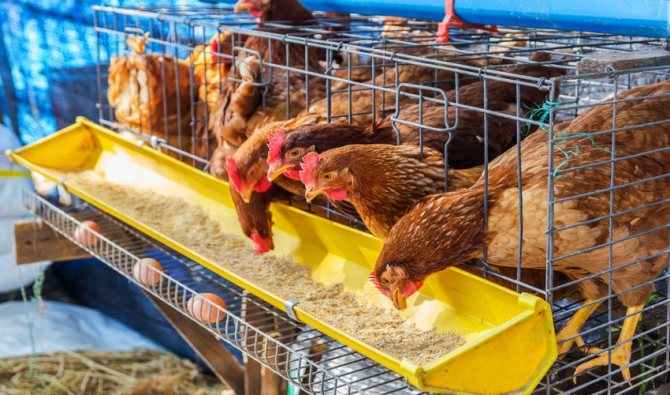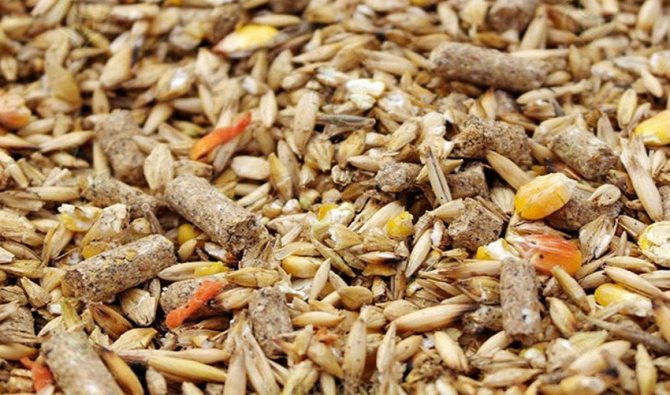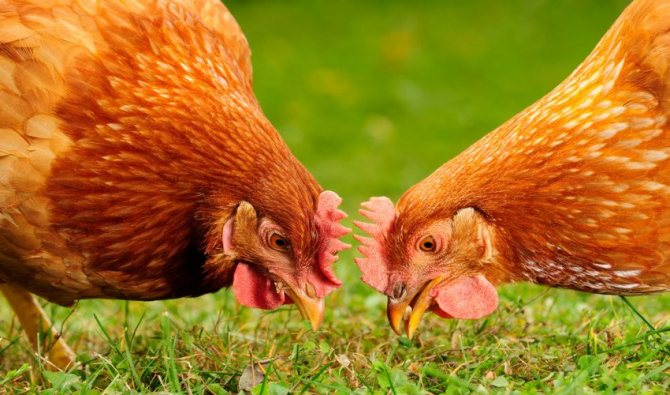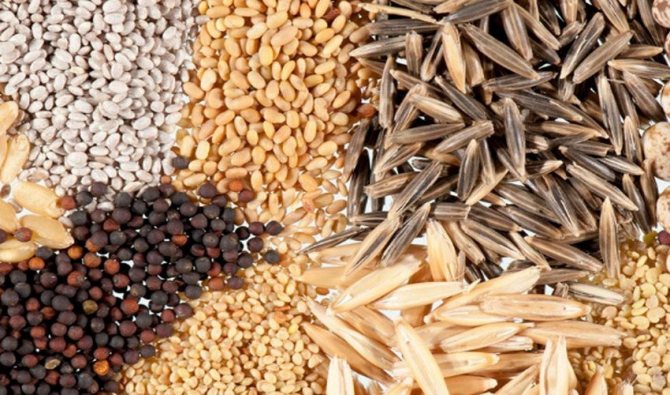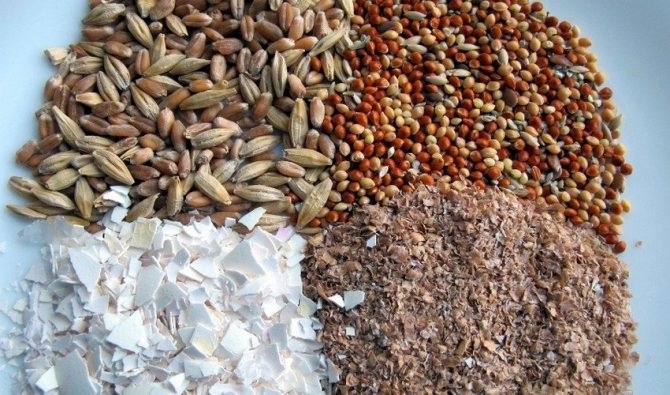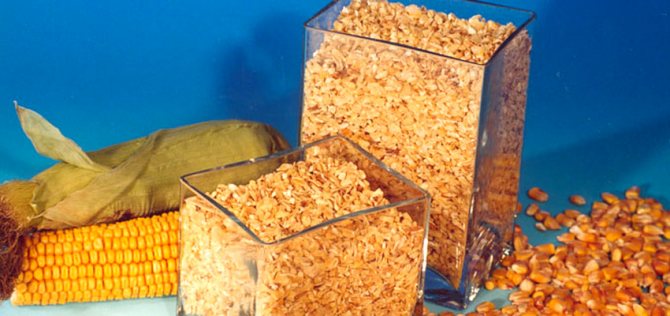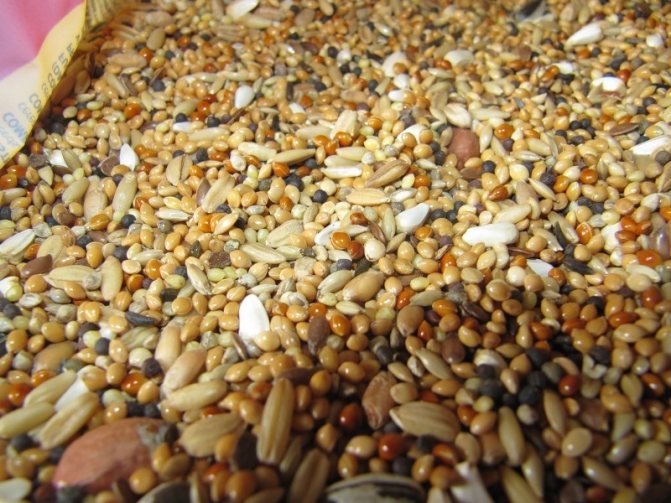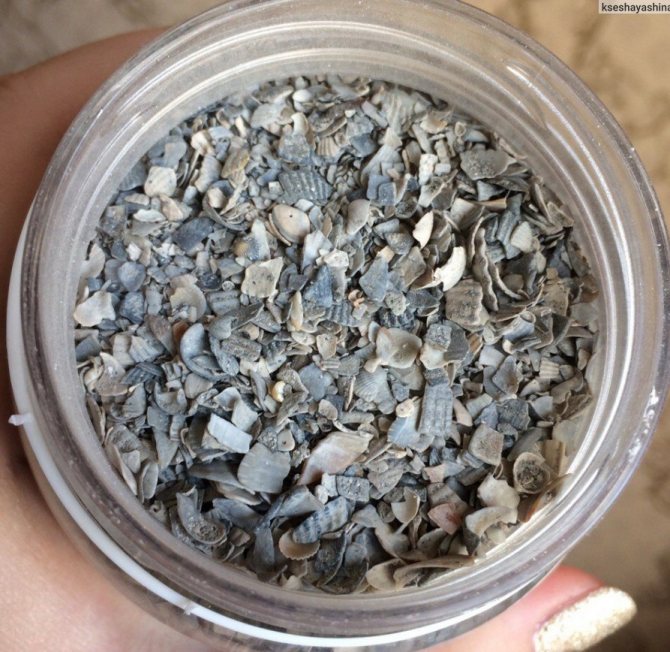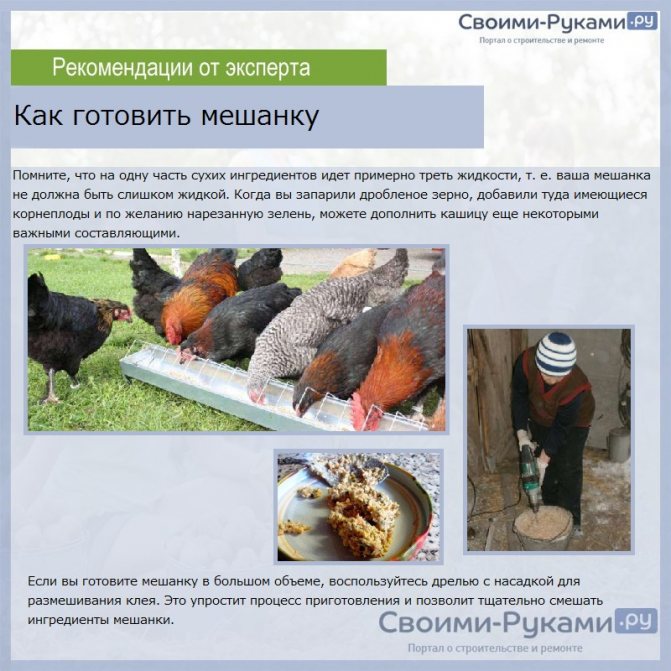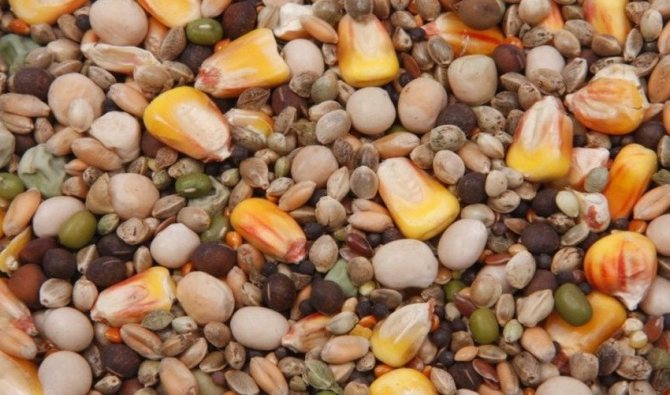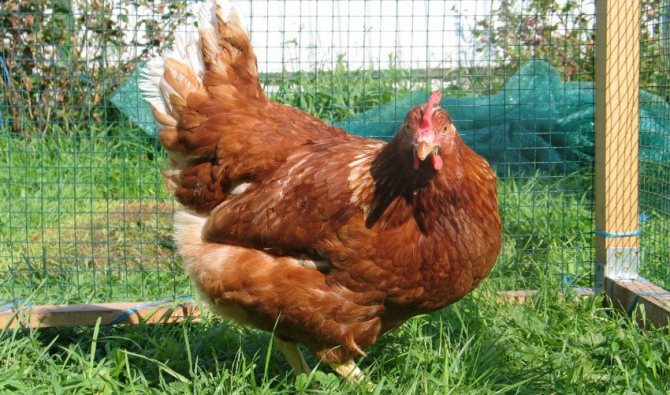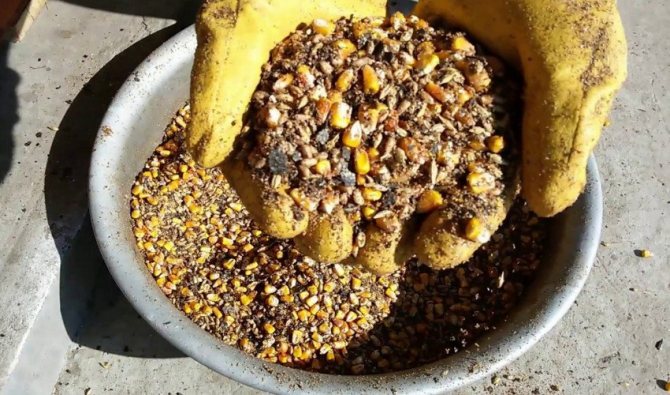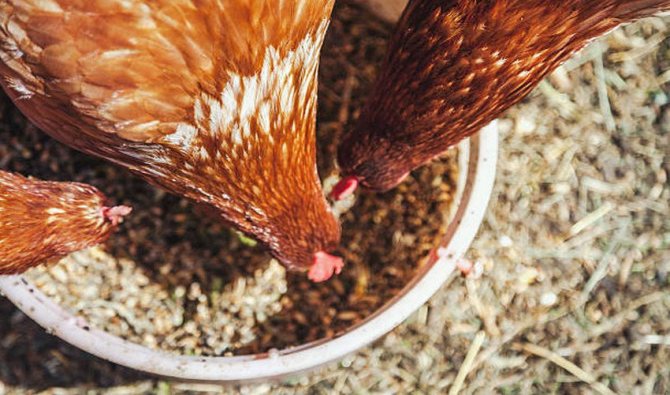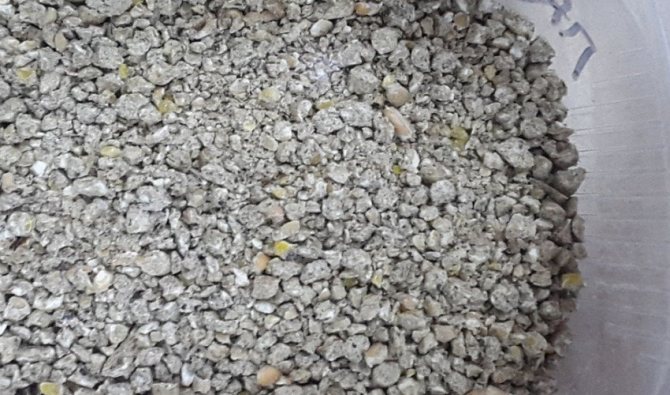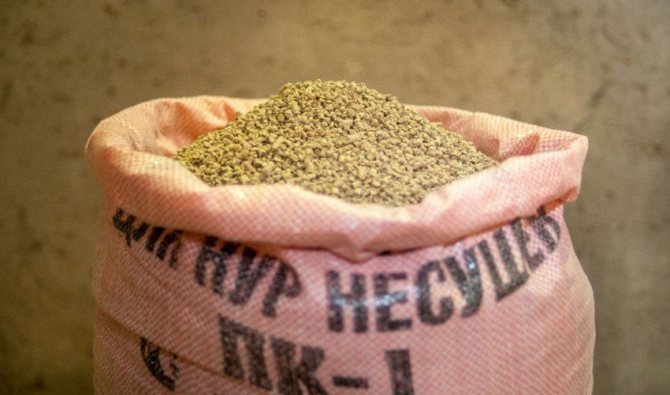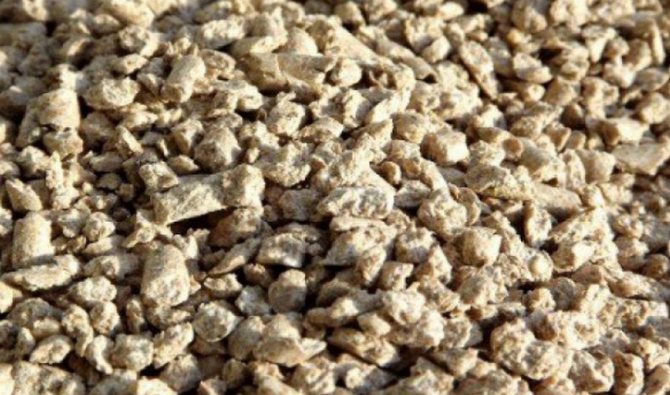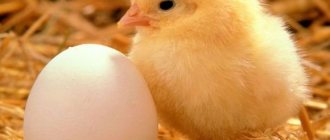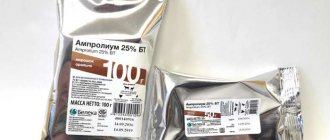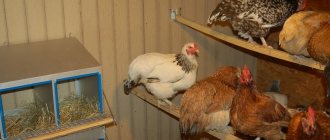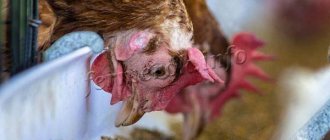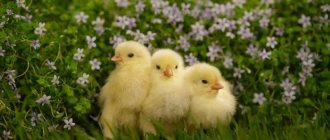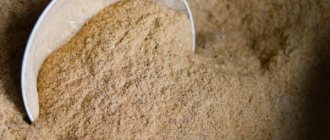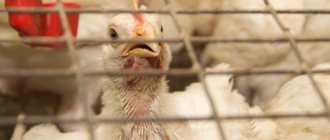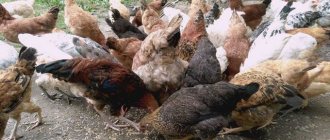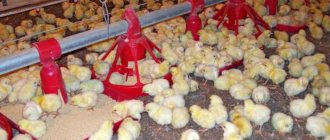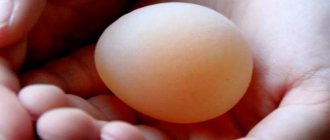A balanced diet for laying hens is the key to good egg production and future profits. Poultry farmers buy ready-made feed or make up nutritional mixtures themselves. Experienced farmers have developed optimal rations for different ages and breeds of chickens, taking into account their condition. Try a few recipes and choose the ones that will especially appeal to your wards.
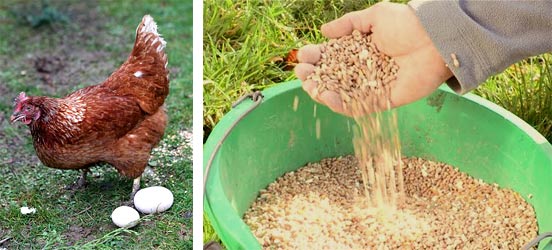
How to make compound feed for chickens
The main components of compound feed
The traditional feeding system assumes that layers are given grain, vegetables, herbal supplements. If the chicken is free-range, its diet expands. In addition to all of the above, it eats insects, lizards and frogs. Poor quality food leads to a deterioration in health, a decrease in egg production, and the development of dangerous intestinal infections.
To avoid such a development of events, laying hens should be given compound feed. It is made from natural ingredients and contains a sufficient amount of proteins, carbohydrates, fats, fiber, vitamins and minerals.
The composition of the product depends on the age of the bird and its needs. Most ready-made feeds contain wheat, corn, barley, sunflower meal (meal), mineral additives and vegetable oils.
Features of compound feed for chickens and broilers
Dry compound feed is a popular and affordable type of feeding for modern poultry. The ingredients are designed to meet the needs of layers and heavier birds such as broilers. Compound feed allows you to restore nutrients, it is considered a safe and convenient form of feeding. But recently it has been noticed that the composition of the compound feed is different.
There are times when farmers purchase low-quality feed and find out about it only after opening the container. This is due to the fact that manufacturers add spoiled grain, save on vitamins and supplements. It makes no sense to consider the criteria for the right choice. The best option would be a specific manufacturer tested over the years. The composition must take into account:
- shredded but natural grain;
- sunflower cake, soybeans, legumes;
- vegetable fats, vitamin complexes, calcium carbonate, salt.
The main component of chicken feed is balance. There are many species that are suitable for different age categories of birds.
Consumption rates of compound feed
With traditional feeding systems, it is difficult to ensure that all chickens receive the same amount of nutrients. The most active birds get grain, while the rest have to finish off the bran and shell.
In the case of compound feed made in accordance with GOST, there are no such problems. The product contains the ingredients necessary for high performance, rapid growth and development. Norms depend on age:
- 7-21 days - 10-25 g;
- 1-2 months - 30-50 g;
- 9-16 weeks - 55-70 g;
- 17-20 weeks - 70-90 g;
- 21-27 weeks - 100-110 g;
- 28-45 weeks - 110-120 g;
- 11.5 months and older - 120 g.
The amount of feed can be adjusted depending on the weight of the birds, the season, the presence or absence of additional food sources. Care must be taken to ensure that the chickens do not starve or overeat.This negatively affects their health, well-being, egg production.
The number of feedings depends on the age. Adults feed twice a day (morning and evening), young animals - more often.
Role of shell rock
As stated above, calcium is one of the most important elements in the diet of laying hens. In this regard, shell rock (crushed shell) is an excellent source of calcium. It has good digestibility - about sixty percent, and also aids in digestion. Like river sand and small pebbles, the crushed shell is involved in grinding food into the goiter.
The daily norm of shell rock is six to nine percent for adult chickens. and about two percent for young animals over three days of age. In this case, it is enough to prepare a special container for the product and constantly fill it with a fresh portion of the shell. Read more about shell rock in the diet of laying hens here.
What compound feed to feed the hens
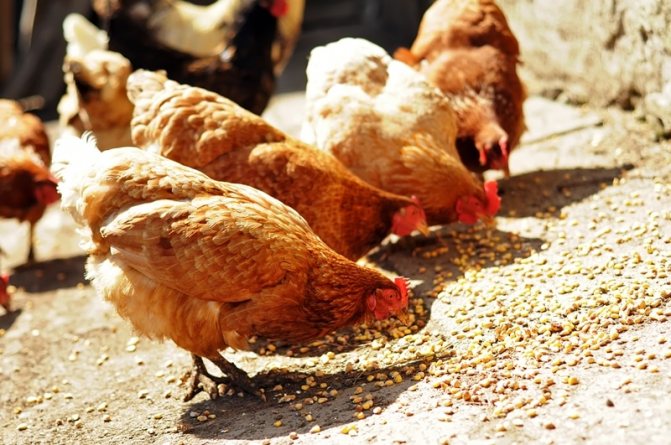

Many poultry farmers are wondering what compound feed to feed the hens. When choosing a product, you need to pay attention to the following:
- Structure. Not all manufacturers are bona fide, so before buying it is worth checking what the feed is made of. It should contain a sufficient amount of grains, as well as vitamins and minerals.
- A type. Feed can be friable and granular. The former are better absorbed and are suitable for birds kept without range. The latter stimulate the digestive tract and are produced for active birds.
- Purpose. The feed is designed for birds of different ages (adult layers, young stock, chickens), so before buying you need to talk to a consultant or carefully study the information on the package. Some products say that they increase egg production, immunity, the number of fertilized eggs, etc.
Premixes are a good addition to feed - special additives that satisfy the need for vital vitamins and microelements. Their use has a beneficial effect on the well-being of birds, their growth and development, productivity, immunity.
The choice of compound feed
The choice of compound feed can be a problem for a novice poultry farmer, since it is difficult to navigate in hundreds of species. Experienced bird keeping specialists identify the leaders in the production of feed:
- Global Agro;
- Cherkizovo;
- Cargill;
- Miratorg;
- RusAgro;
- White bird.
On a note! Each of the companies offers various options for combined feed. When choosing, take into account the age, composition, form of release. It is more profitable to purchase compound feed in bulk, as this increases the economic benefits of poultry farming.
Feeding chickens at different times of the year
In the cold season, the chicken spends energy not only on the formation of eggs, but also on maintaining a high body temperature. In spring and summer, free-range birds receive additional nutrients from insects, worms, and green grass. This is not possible in late autumn and winter, so it is necessary to ensure that the diet of birds is complete and balanced.
Recommendations for feeding hens during the cold season:
- If in the summer 2 meals are enough for the chicken, then in the winter you need to give food at least 3 times a day. Mushrooms and juicy feed are fed before lunch, dry ones are given at night.
- Food should contain sufficient amounts of vitamins and minerals. To avoid the development of deficiencies, you can use special additives, high-quality hay, paws of conifers.
- Winter is not a reason to give up juicy feed. Some poultry farmers give chickens a pumpkin cut into several pieces.
- Many nutrients are found in sprouted grains, dried nettles. Minerals are found in dairy products, fish meal and bone meal. All of these foods need to be included in the diet.
DIY compound feed for laying hens - recipes
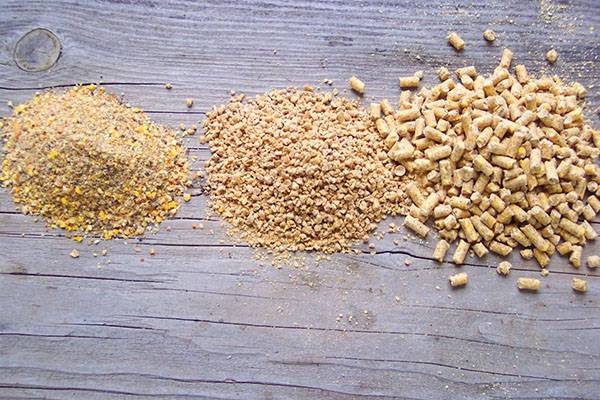

If there is a walk for chickens in a fenced area, then it is better to plant beds with green grass (clover or alfalfa) or just with herbs (dill, parsley) there. In this case, the amount of green grass in the feed can be significantly reduced. But with the arrival of the cold season, dry herbs will certainly be included in the recipes for homemade food, which contain the bulk of vitamins and minerals necessary for laying hens for good nutrition.
Preparing compound feed for individuals of the egg direction is not as difficult as it seems at first glance. The main thing is to properly prepare all the ingredients that will be part of such a homemade variety of bird food. One of the ingredients is herbal flour, which is usually made from:
- clover;
- alfalfa;
- nettles.
It is best to collect this herb before the budding begins - in this case, the vegetative part of the plants retains the greatest amount of valuable substances and vitamins.
In late autumn, poultry breeders store needles, especially where it was not possible to stock up grass in summer. But in the spring it is not worth stocking up needles - the resin begins to move in it, so it is not suitable for food for birds. The needles are dried in the shade in a draft, then crushed and added to the mash. But many simply hang coniferous branches in the poultry house at such a height that it is convenient for chickens to peck at it.
But the main ingredients of any homemade food are wheat, corn, oats and barley. In the warm season, grain can be given both whole and crushed. And in winter there are fewer vitamins in compound feed, so grain crops must first be germinated.
But you need to remember that it is better to soak each type of grain in separate containers and give each sprout to the chickens in turn.
Grain is poured with water at room temperature for 1-2 days, as soon as sprouts appear - food, in which there are many necessary vitamins, is ready. Such seedlings are quickly digested by poultry.
Yeast can be added to wet grain mash, with the help of which the feed is enriched with B vitamins and prebiotics. Such a component is usually added to compound feed in the autumn-winter period in order to increase the egg production of poultry, which may decrease slightly in winter.
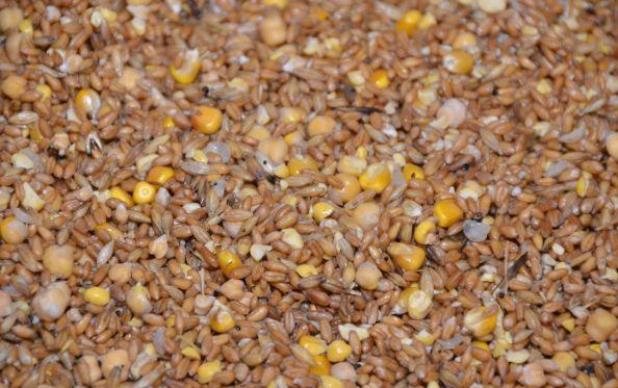

The following components should be included in an exemplary menu for home laying hens:
- carbohydrates;
- proteins;
- fats.
The carbohydrate component of compound feed is cereals, which are a source of energy. Legumes (peas, soybeans), as well as cake (soybean or sunflower) are a source of protein for chickens. And protein is necessary for chickens for rapid growth and strengthening of immunity.
Also, hens need mineral supplements (in particular, calcium) to keep the eggshell strong and durable.
An approximate menu for chickens over 4.5 months old may look like this:
- wheat, oats or barley - up to 50 g;
- grain flour - 50 g. It is a mixture of oat flour with wheat bran. But oats can also be substituted for barley. Such flour is well absorbed by hens; it is usually added to wet mash;
- grass flour - fresh or dried (10 g). It is prepared from specially harvested herbs and needles, this component provides chickens with vitamins;
- carrots, turnips, rutabagas, zucchini, pumpkin - 50 g. Pumpkin gives a bright orange color to the yolk;
- bone meal (meat or fish) - 2 g. But you can replace such flour with boiled fish;
- cake - 15 g. Any of the cake can be added to the wet mash: soybean, sunflower or flaxseed;
- table salt (0.5 g) is added to food in order to enrich the body of chickens with sodium ions;
- it is imperative to introduce shells into the diet of laying hens, which contribute to a faster digestion process.
Laying hens can be fed up to 3 times a day.
Types of factory feed
Compound feed for laying hens differs from products intended for meat poultry. He is able to replace grain and other food, become the only source of nutrition. The main thing is that the food meets the age, weight, and needs of the birds.
The stores offer a wide range of feeds: loose, expanded and expanded-granulated. Expansion is a short-term hydrothermal treatment of a product. Feed prepared using this technology provides a rapid increase in weight gain, increased productivity, shorter feeding times, and reduced morbidity and mortality.
PC-0
Compound feed for chickens fed for meat. Used during the first 2 weeks of life. Contains vitamins, micro- and macroelements, beneficial bacteria and other substances necessary for the rapid growth of chicks. The calorie content of 100 g of the product is 300 kcal.
An additional component of the mixture is sodium lasalocide, which prevents the development of coccidiosis, a common infectious disease.
PC-1
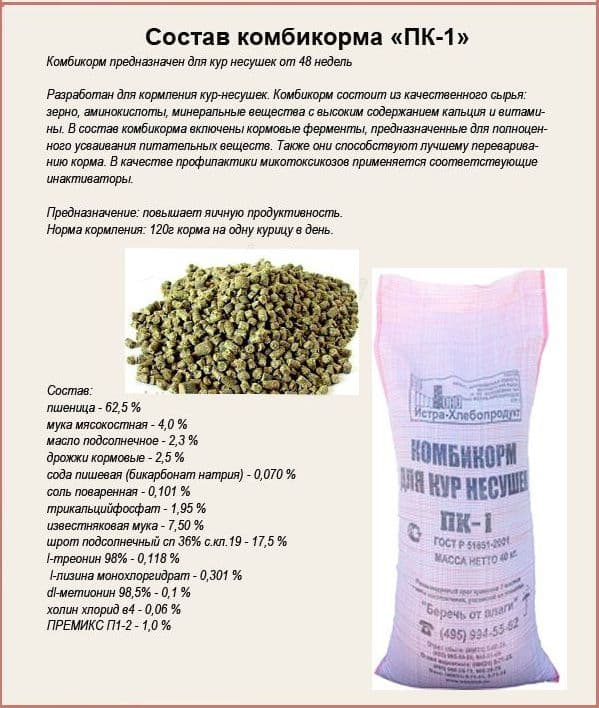

Composition of compound feed PK-1
Complete feed containing 16% protein, a large amount of vitamins and minerals. Designed for birds over 1 year old. Each 100 g of product contains 269 kcal.
There are several varieties of this compound feed:
- PC 1-18. Used during the first and second months of life.
- PC-1-1. It is applied after 1 year. Improves the quality of eggs, improves their taste. When using the feed, the chicken fluff thickens, the eggshell becomes harder and the yolk becomes bright orange.
- PC-1-25. Used for feeding birds over 12 months old. Differs in a thoughtful and balanced composition. Contains enzymes, prebiotics, antioxidants. Prevents the development of coccidiosis.
Some packages have the abbreviation KK, which means "concentrated feed". Such a product consists of wheat bran with the addition of cake, fish meal, barley waste, shells, limestone. It can be used as a dietary supplement (in addition to the main diet).
PC-2
Designed for young individuals (1-8 weeks old) that will subsequently lay eggs. Available in granular or loose form. Contains 290 kcal (per 100 g) and 18% protein.
The mixture ensures the rapid growth of birds, prevents the development of diseases (it contains small doses of drugs).
PC-3
Designed for egg chicks from 21 days of age, sold in loose form. When the bird reaches the age of 14 weeks, it is transferred to the PK-4 compound feed, and after 4.5 months, it is returned to its previous diet and left on it for up to 20 weeks. The product accelerates development, ensures the correct functioning of the reproductive system.
Energy value is 260 kcal, protein content - 16%. Feed should be given in the dosage indicated on the package (depending on age).
Unique compound feed PK-7
It is used for feeding crosses - hybrids of breeds, the age of which varies from 18 to 22 weeks. It is difficult to buy it. Most often it is made to order.
Types of the best products and their prices
Wet food - self-prepared mash in water, dairy products or broths. Dry food is the above-described compound feed (purchased or grain mixture). Prices for ready-made dry food depend on the amount of purchased volume. It is more profitable to buy in bulk.
The price also depends on the composition, for example, complete feed (PC) will be more expensive than concentrated feed (CC).
It is necessary to choose compound feed based on the age of the bird. Retail cost for various feed ranges from 12 to 34 rubles (average market prices are indicated):
- compound feed PK 2 for chickens from 1 to 7 weeks costs 33.75 rubles per 1 kg;
- food PC 3 for layers from 8 to 20 weeks at a price of about 22 rubles per 1 kg;
- PC 4 for layers from 14 to 17 weeks costs 19.25 rubles per 1 kg;
- PC 1-1 for layers from 21 to 47 weeks will cost 20 rubles per 1 kg;
- food PC 1-2 for chickens from 46 weeks - at 19.25 rubles per 1 kg;
- CC 1 for laying hens is the cheapest - 12 rubles per 1 kg.
Reference! Grain mix made by yourself is cheaper.
Balanced food composition
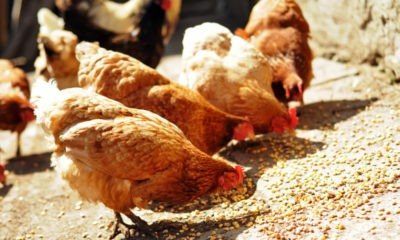

Factory feed is considered to be truly balanced, it not only takes into account the composition of the food, but also the proportions. Mineral and vitamin supplements are also included. Therefore, this feed allows you to achieve the highest egg production rates at any time of the year. It allows hens to get the required amount of crude protein, fat, amino acids, calcium, phosphorus, etc.
It is difficult to say which feed to use, since the egg production rate depends not only on the feed, but also on the conditions of keeping the layers in general. Traditionally, the composition of the factory balanced chicken feed should include (the concentration of the components varies depending on the age of the layers):
- corn;
- cake;
- corn;
- chalk or shell;
- feed flour;
- fish flour;
- meat and bone meal;
- wheat bran;
- salt;
- premix.
Which product is the best?
The food PC 1 has won the greatest confidence among buyers. All the necessary elements have been added to its composition, so there is no need to think over the diet of chickens, that is, saving time. Compound feed KK 1 is also quite good for feeding hens, although it contains less vitamins and minerals than PC 1.
Reference! It is recommended to give it as an addition to vegetables and herbs, or as a main food fortified with premixes.
For egg production
For egg production, feeds are chosen that contain whole grains of wheat. But it is alternated with oats, corn.
Be sure to include roots and vegetables in the diet. Greens have a beneficial effect on the carrying of eggs, since they contain a lot of vitamins. Choice of greens for chickens Perfectly fresh to give chickens:
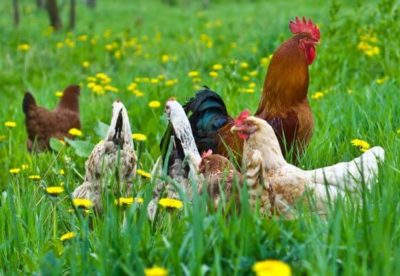

dandelions;- nettle;
- clover;
- spurge;
- sorrel;
- dill;
- parsley;
- lutherne;
- plantain;
- leaves of cereals and tops of vegetables.
And for the winter, dry these herbs in bunches, which are freely available to hang in the chicken coop. In general, greens make up 30% of the total poultry diet.
Carbohydrate feed
For normal life, birds need a large amount of energy, which they receive from carbohydrates. Feed with a high content of these organic substances slows down the metabolism, promotes rapid weight gain (which is necessary when raising poultry for meat). There are different types of carbohydrate feed, depending on the composition.
Cereals
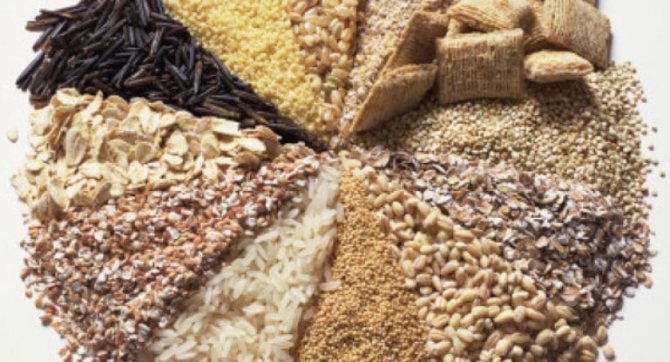

For a chicken to be healthy and rush well, its diet must contain grain of any grind (at least 50% of the total food volume).
The following cereals are used for the production of grain feed:
- Corn. It is the most valuable and useful component. Contains a large amount of protein and a minimum of fiber (chickens have difficulty digesting it, which leads to intestinal blockage and death).
- Wheat. The volume of this component in the finished product cannot exceed 30%. For the production of feed, feed wheat is often used, which is high in vitamins E and B.
- Oats. It is considered a dietary product rich in amino acids. Contains a lot of fiber, which negatively affects the state of the gastrointestinal tract, therefore it is used in limited quantities. The share of crushed grain in compound feed should be no more than 20%. The size of the fractions is selected depending on the age of the chickens for which the feed is intended.
- Barley. It is cleaned and sieved and then used for the production of feed. You cannot use unrefined grain, since there is fiber in its shell.
- Buckwheat. It is rarely used, because it does not like birds and is poorly suited for feeding them.
- Rye. Experienced poultry farmers do not buy feed that contains this product.As for freshly harvested grain, it is not given to birds because of the high concentration of mucus (it negatively affects the state of the digestive tract).
Juicy feed
As a juicy feed, you can use vegetables that have been peeled beforehand. The most common options are:
- Potatoes. Birds prefer to eat boiled tubers that are cut and dehydrated. It is not recommended to give a raw vegetable, as well as a green one (the latter contains solanine, a poisonous organic compound). As for boiled potatoes, it satiates well and improves digestion.
- Pumpkin. Contains carotene, sugar, vitamin B2. Before giving the pumpkin to the birds, it is split into several pieces or cut with a knife. It is necessary to ensure that the amount of food in the diet is at most 15%.
- Beet. It is used boiled or fresh (in the latter case, it is chopped on a grater). In order for the product to retain its beneficial properties, it must be stored in the freezer. Defrost the beets just before eating. The maximum share is 15% of the total food volume.
Grain waste
Poultry rations can be supplemented with waste from grain processing. This is often discouraged due to its low energy content, lack of health and performance benefits. These products are inexpensive, but contain many harmful components (including fiber and fungi). An example of an additive that is used to feed poultry is wheat bran.
There are other types of poultry waste as well. One of them is stillage - a by-product of the production of alcohol, which is potato, corn and wheat. The latter is the most nutritious, contains a large amount of B vitamins and can make up 10% of the diet.
Feed making equipment
To create compound feed for laying hens with your own hands, you will need a feed or flour mill. With its help, it will be possible to grind grains and other products on their own. If you have to buy grains, you should consider storing them. It is worth making a storage with partitions for each type of feed ingredients.
Farmers are able to build a small mill at home on their own. For this, several containers are built for different feed components, and a grain crusher is placed next to them, which will be easy to move. This will make it easier to quickly select the right ingredients and add them to the mill. The containers are cleaned once or twice a year to prevent pests.
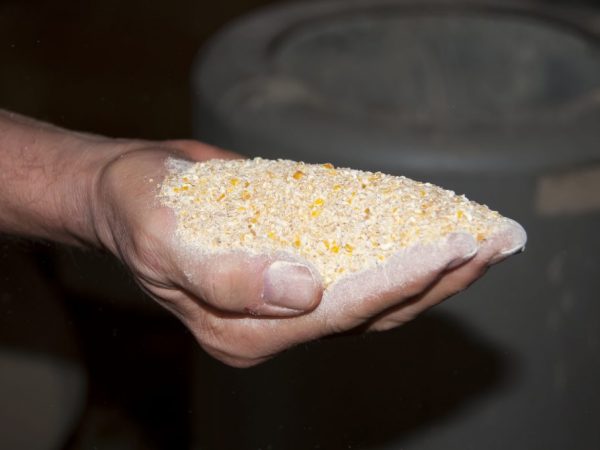

Mixed feed for hens is made using a mill
Protein feed
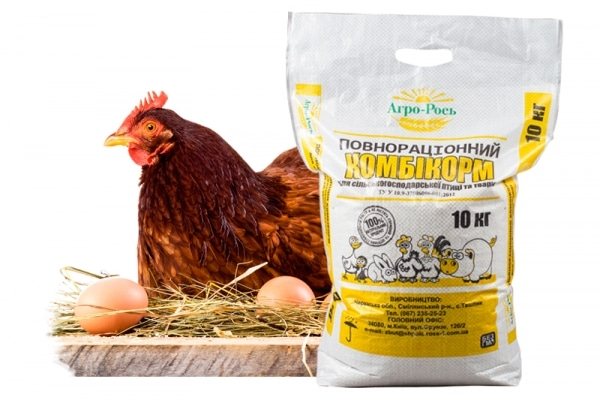

An obligatory component of the menu should be animal or vegetable protein containing amino acids and other valuable substances. When it is used, the development of young stock is accelerated, the productivity of adult layers increases, and the quality of egg white rises.
Animal squirrels
Proteins of animal origin are used more often because they contain a lot of vitamins and minerals. Most often, poultry farmers give pets the following products:
- Fish meal (up to 8% of the diet). Highly digestible, contains valuable amino acids. Produced from fish and waste by grinding. The product can only be included in the diet of layers. It is undesirable to give it to broilers, since it gives the meat a specific fishy smell.
- Bone flour. It is made from bones and meat, contains vitamins E and A. It is used for feeding birds older than 1 month.
- Blood meal (up to 4% of the diet). Made from blood and bone. May cause digestive upset if consumed in large quantities.
- Milk products. Contains a lot of protein, is well digested and absorbed. In wet mash, you can add products such as milk, cottage cheese, whey, reverse (skim milk, in which there is practically no fat).
- Earthworms. Protein-rich top dressing. You can collect worms after rains, but it is long and inconvenient.It is much easier to grow them yourself, in a separate box. The rate of worms per 1 individual varies from 5 to 7 g.
- Feather flour. Attracts novice poultry farmers due to its low cost. You can use it little by little (up to 2%), since there is little use in it. The low value is due to the poor composition (the product consists of bird feathers and down).
Vegetable proteins
Popular sources of protein are:
- Meal, cake. Most often it is made from soybean seeds, sunflower seeds. The optimal proportion in the diet depends on the age of the chickens: 10% for young animals, from 15 to 17% for adults.
- Soy. In terms of nutrient content, it practically does not differ from animal protein sources. Contains proteins, amino acids, minerals, vitamins.
- Peas. The maximum content in compound feed is 10%. It has a beneficial effect on well-being and growth due to its high concentration of amino acids and protein. Crushed peas have a specific taste and smell, so birds do not like it.
Composition of compound feed
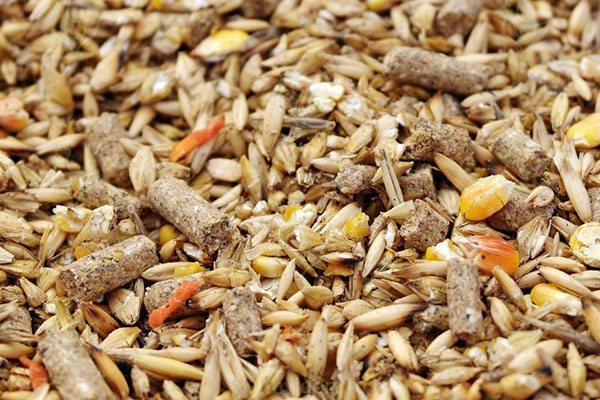

In order for chickens to have excellent health, you need to invest in their nutrition and control what the birds eat in the yard. But if you keep track of what the birds are gathering in the grass, it is almost impossible, providing them with high-quality food is not so difficult.
There are countless types of feed for chickens, so you need to make a choice based on your financial capabilities, the preferences of the birds themselves, their age and the general state of organisms.
Among the options for feed for chickens, there are protein, carbohydrate, mineral and vitamin mash. What are the features of each type of grain feed for chickens?
Protein mash of animal origin
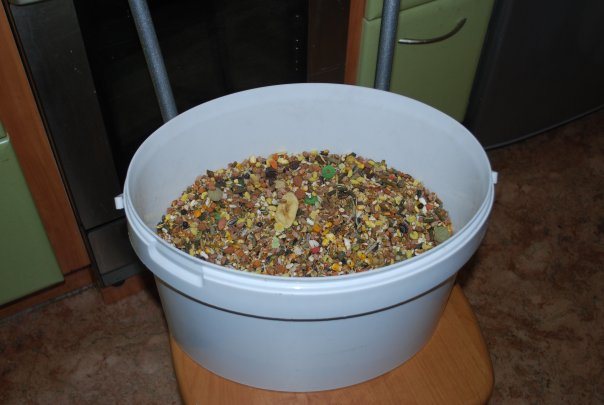

Most supplements are sold and produced in flour form. But what kind of flour can there be? The most popular is fishmeal, which is created by grinding fish seeds and dense fish waste.
Fish protein is quickly absorbed by the chicken, but due to the increased concentration of amino acids in it, it has a peculiar aroma.
To get rid of the unpleasant odor of poultry meat, we recommend eliminating fishmeal from the diet of growing broilers. But in the diet of laying hens, such a product should be at least 8%.
Bone meal is the product of grinding meat and skeletal parts of farm animals. This feed material contains the same amount of protein as there is in cereals, the ash concentration is 30%, and the fat content exceeds 11%.
Bone meal contains not only protein, but also calcium, so it helps to strengthen the skeleton and quickly build lean muscle mass.
However, such a product may be too dangerous for young females less than one month old, so it is best to avoid getting bone meal in chicken feed. The same rule applies to blood meal, which consists of the blood and bones of cattle.
The increased concentration of amino acids and protein can lead to troubles with the digestive system in birds of any age. Therefore, it is especially important to ensure that chickens receive up to 7% blood meal per day. Another type of low-demand flour is called feather flour.
Feather flour, which is easy to understand by the name, is made from the plumage and down of poultry. Such a product is useful, but only in limited quantities, so one chicken should account for up to 2%.
There are also alternative protein supplements for chickens. Experienced chicken farmers dig out earthworms for their pets or even raise them on their own in wet containers with weeds, rot, and moisture-holding materials.
When choosing the number of worms, you need to calculate by weight: about 6 grams should fall on one bird. But the most readily available are dairy products. Cottage cheese, whey and milk of not the first freshness do not have any worthy substitutes for feeding chickens. They contain an increased concentration of vitamins, minerals and glucose.
Carbohydrate feed
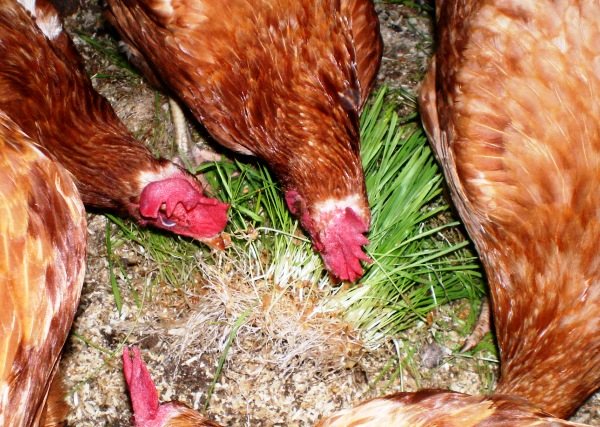

Poultry foods that are high in carbohydrates are called carbohydrate foods. Usually it is a mix of seeds of different types, juicy vegetables and waste from alcohol production.
Carbohydrates are the most important sources of energy for the chicken body, so their content is necessary in any feed. This is especially true for feed for broiler chickens, which need to grow quickly and gain live weight. As we mentioned, there is a grading of carbohydrate feeds.
Thus, cereal carbohydrate feed should make up at least 50% of the poultry ration. It is necessary to compose grain mixtures from corn (the most useful type of grain for chickens), sprouted oats, feed wheat.
Some also add grain waste, but don't give too much bran and other things: they can contain ergot, dangerous fungi and weed seeds.
Juicy vegetables include sugar beets, turnips, fresh rutabagas, radishes and turnips, cabbage and potatoes; ripe pumpkin is also suitable for chickens. All such feeds are produced strictly in accordance with GOST, and experienced chickens are advised to store them frozen and give them to the birds only after quick defrosting.
It is dangerous to give the birds stale vegetables bought at a reduced price, for example, a toxic substance called solanine is formed in potatoes.
In general, vegetables should make up no more than 15% of the total diet of chickens, otherwise their digestive system can be seriously affected. If you can experiment with grain components of compound feed and homemade ingredients, it is not advisable to give chickens other vegetables.
As mentioned earlier, industrial products are used for additives in carbohydrate feed. We are talking about stillage - thicker from the distillation of potatoes, wheat and corn.
The most nutritious of the listed substances (wheat stillage) should make up to 10% of the diet of an adult chicken or layer. Such fodder material contains a lot of vitamin B, fiber, in the amount of which stillage is not inferior to real oats.
Sometimes waste from the production of molasses and starch is added to carbohydrate feed. But what remains from the digestion of sugar beets should be up to 7% of the total amount of daily food for one bird at home.
Vitamin and mineral compound feed
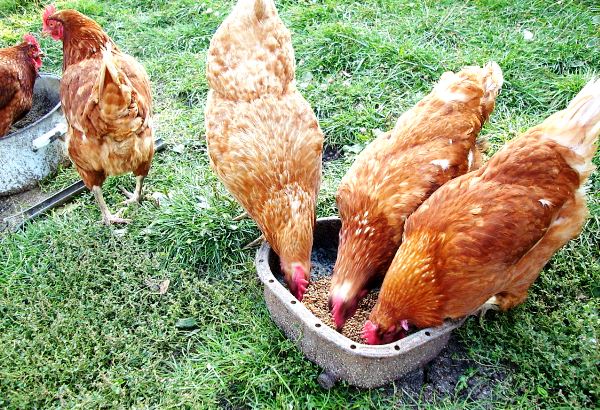

Food for poultry with a high content of vitamins and their complexes is called vitamin. In fact, a vitamin compound feed is a regular carbohydrate or protein feed with special additives.
They can be purchased on the market, in a specialized poultry store, but you can also make them yourself. In this case, the process of compound feed yeast is carried out.
How to properly yeast 100 kilograms of chicken feed?
To do this, follow the instructions:
- Fill the working container with up to 9 liters of water. It is important that its temperature does not exceed 40 degrees Celsius. Pour baker's yeast into the water in the ratio of 1000 grams per 100 kilograms of feed. The mass is stirred until smooth.
- To increase the calorie content of the vitamin compound feed, 5 kilograms of molasses, a liter of sour cow's milk and about 3 kilograms of sprouted barley grains are added. What comes out after careful stirring is filled with 170 liters of heated dechlorinated water.
- There you need to unload 100 kilograms of yeast feed, and then leave the mixed feed for 7 hours with regular stirring. It is worth noting that you need to use yeast food within 2 hours after the end of cooking. After that, the processes of formation of fungi, souring of chicken feed will begin.
Mineral feeds are also feeds with conventional additives. They should contain the most common macronutrients: sodium, potassium, chlorine, sulfur, magnesium, phosphorus and other chemicals necessary for the functioning of the body.
To add all of them to the diet of chickens, you need to flavor ordinary grain and vegetable feeds with table salt, grated or crushed shells, feed chalk, eggshells, ash and limestone.
It is necessary to control the amount of minerals and vitamins in the feed, since their excess is no less harmful than the lack itself. To facilitate the feeding process, you can buy ready-made vitamin and mineral complexes.
These include additives "Selskiy Dvorik", "Ryabushka", "Agroservice", "Solnyshko" and "Broiler Economy". All differ in price, but clear instructions on the packaging will save you from fatal mistakes.
Compound feed for chickens
Chickens of egg breeds grow quickly and begin to lay eggs at 4-5 months. To speed up the development and maturation processes, you need to carefully monitor the nutrition of future layers.
You can feed chickens with mash - crushed grain with the addition of chopped greens, dairy products, sunflower meal, salt, nettle, chalk and shells. In order for the chicks to eat the mixture with pleasure, you need to make it crumbly.
If desired, you can use ready-made feed and vitamin and mineral supplements. Granular species are allowed to be given, but only after thorough grinding. Chickens are not able to crush and swallow pellets on their own.
Popular food for chicks of egg breeds:
- "Sun".
- PC-2.
- PC-3.
How to choose the best one?
Choosing feed for your hens is a demanding task that can seem daunting for a novice chicken breeder. But any experienced specialist can easily find the optimal compound feed on the shelves in the store.
What is the secret to choosing the right feed?
Finding a suitable one is easy if you know the decoding of state markings:
- "PK0" is placed on feed suitable for chicks in the first 96 hours of their life.
- "PK1" is intended for laying hens and breeding birds. The balanced composition of the feed allows the poultry body to quickly recover from regular egg laying, and also improves the taste of chicken eggs.
- "PK2" is suitable for birds in the first 60 days, it contains special ingredients that chickens need to form internal organs, stimulate the growth of females and their rapid puberty.
- "PK3" and "PK4" are suitable for feeding growing birds. The nuance is that "PK4" is used from 3.5 to 4.5 months, and from 2.5 to 5 (excluding this period), you need to use the first type of feed for chickens. The main function of such food is to prepare the chicken's body for the start of laying eggs, as you know, most birds begin to lay at this age. It is worth noting that during this period and further, feed with the state marking "P7" is suitable for males.
How to prepare compound feed yourself
Some farmers choose to prepare their own feed at home if they think this is more profitable. Before creating a product, you need to choose a suitable recipe and prepare the necessary ingredients.
To make high-quality feed that is useful for birds, you need to strictly adhere to the instructions (use all the listed components in the specified quantities). Failure to comply with this recommendation will lead to an unbalanced product, which not only will not bring benefits, but can also harm.
Popular recipes:
- Take 65% Wheat Grains. Add 19% sunflower meal, 7% lime flour, 5% ground meat and bones, yeast and sunflower oil (2-3% each), salt and soda (0.1% each). Add 1% vitamin and mineral supplement P1-2. To stir thoroughly.
- Mix 45% corn and 10% peas. Add 12% of a mixture of wheat and barley, 8% meal, 2% chalk, as well as fish, bone and grass meal (2 to 4% each). Add a little baking soda and salt.
- Mix 500 g of wheat grains, 300 g of barley, 50 g of bran, 100 g of sunflower meal. Put 40 g of bone meal, 60 g of shells, 20 g of vegetable oil, 30 g of chalk, 3 g of salt.Add 1 g of premix to ensure a high mineral and vitamin content.
Basic recipe for compound feed for layers
Try a simple corn-based dry mix. If desired, the corn base can be replaced with rye or wheat. The choice depends on your financial capabilities and preferences of chickens.
Experienced poultry farmers recommend observing laying hens. The birds themselves will tell you. What kind of grain do they like best.
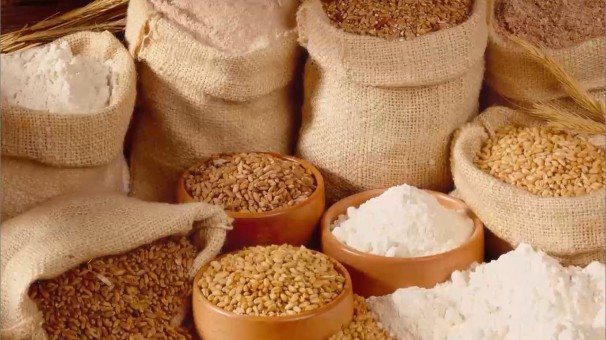

We prepare compound feed for hens and chickens
From the proposed components, about 1 kg of the product is obtained:
- corn grains 500 g;
- wheat 150 g;
- barley 100 g;
- sunflower (meal) 100 g;
- meat and bone or fish meal 140 g;
- chopped hay 50 g;
- food salt 3 g;
- feed yeast 50 g;
- peas 40 g;
- vitamin complex 15 g
The compound feed can be prepared in advance, it is well stored in a dry room. The prepared complex is used as a basis for a wet feed mixture or is given independently. To prepare a wet mixture, dry components are poured with whey, broth or just warm water. It has been noticed that hens eat heated feed more readily.
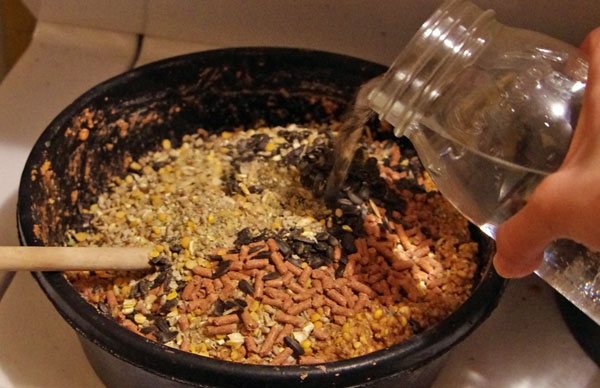

Cooking warm porridge for chickens


How to cook a mash
Another recipe involves the inclusion of vegetables and food waste. The suggested diet is based on whole wheat grains. It is advisable to give such feed once a day, alternating with a dry grain mixture.
The composition is as follows:
- whole wheat grain 750 g;
- boiled potatoes 600 g;
- boiled carrots 300 g;
- combined silo 400 g;
- wheat or rye bran 150 g;
- skim milk 200 ml;
- bone or meat and bone meal 45-60 g;
- food waste (meat or fish) 120 g;
- wheat cake 100 g;
- fodder beets 50 g;
- drinking salt 5 g;
- chalk or crushed eggshell 70 g;
- hay or hay dust - 100 g.
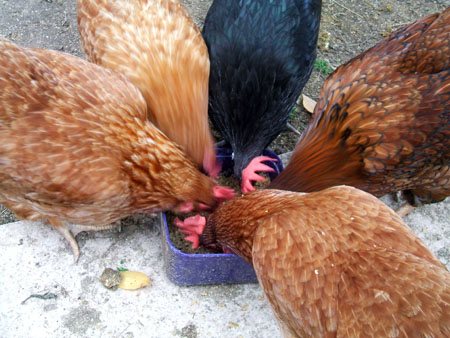

Chickens peck on a wet mash
The basic recipes can be changed while maintaining the basic proportions of the ingredients. For example, whole wheat can be replaced with crushed wheat, supplemented with barley in the grain base. Instead of boiled potatoes, you can use pumpkin, boiled carrots, raw zucchini. An excellent substitute for hay is fresh chopped grass. Fruits can also be included in the vitamin compound feed, for example, carrion apples, pears, and garden berries.
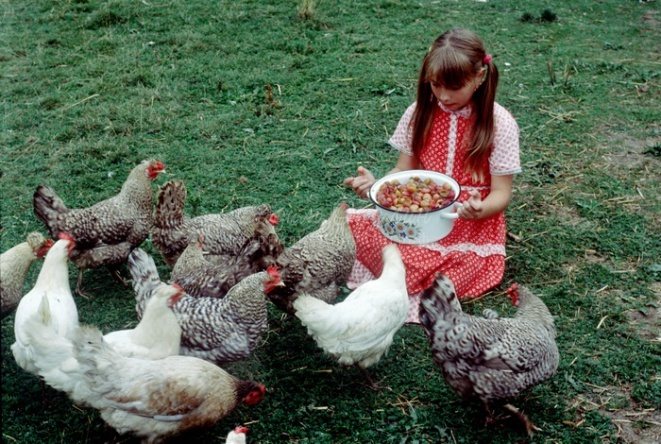

It is good for chickens to give apples and pears
Mixed feed preparation options
There are several ways to create compound feed. The breeder can choose the one that he considers most preferable.
Yeast
Yeast is the process of introducing yeast into cereals, vitamins and juicy feeds. It can be exposed to foods that contain up to 15% protein, free of salt, chalk and shells (these ingredients inhibit the growth of yeast). To speed up the process, you can add salted barley or foods with a high sugar concentration (molasses, sugar beets) to the feed. Yeast is carried out at + 15 ... + 27 ° C. In this case, the feed temperature is + 24 ... + 27 ° C.
To carry out the procedure for 100 kg of raw materials, you need to do the following:
- Fill the container with 10 liters of heated water, put 1 kg of baker's yeast into it. Mix thoroughly until bubbles appear.
- Add 3-4 kg of sprouted barley and 4-6 kg of sugar beets. If the listed ingredients are not available, you can replace them with sour milk (1 liter is enough).
- Pour the finished mixture into 150-200 liters of warm water, stir.
- Add feed, stir and leave for 6-9 hours.
If necessary, the proportions can be changed at your discretion.
The disadvantage of a feed with added yeast is a short shelf life. The product retains its beneficial properties for 2-3 hours, after which it begins to deteriorate and becomes unusable. You need to yeast the amount of feed that the birds can eat in the near future.
Malnutrition
During this procedure, the starch is partially converted into sugar.The food tastes better, so the birds are happy to eat it. Malting involves heating food, so it is not recommended to expose ready-made feed to it (many valuable substances will be lost when the temperature rises).
Algorithm of the procedure:
- Put ground grain in a bowl. Malt can be added if desired to speed up the process (1 to 2 g per kg feed).
- Fill with water at a temperature of + 90 ... + 95 ° С at the rate of 2 liters of liquid per 1 kg of raw materials.
- Close the container with a lid, leave for 4 hours.
During all this time, the grain should be in a warm room. If the temperature drops too much, the malting process will slow down or stop.
Ensiling
As part of this procedure, freshly cut grass is used, which is placed in a silo pit - a structure designed for fermentation and storage of feed. This method of harvesting allows you to create nutritious and tasty food that normalizes the digestive tract and prevents the development of putrefactive processes. The silage contains a large amount of proteins, ascorbic acid, carotene and other valuable components. You can prepare food from alfalfa, ground peas, clover, oat shoots.
Shredding
The grains are covered with a shell that makes it difficult to digest food and consumes a lot of energy. Poultry farmers recommend giving crushed grain to birds. Mechanical processing promotes fast food digestion and increased nutritional value. At the same time, the digestibility and nutrient content remain the same.
The harder the grains, the more they need to be crushed. The softer the feed and the older the bird, the larger the fractions can be.
Granulation
The procedure is aimed at obtaining small, smooth fractions that do not stain the feeders and are well digested. The advantage of pellets is that the chickens have to eat them completely (in the mash feed, birds can choose individual ingredients, so they do not get all the necessary substances).
During pelletizing, the feed heats up, which leads to the loss of some vitamins. However, this cannot be called a significant drawback.
Mixing
When creating a compound feed, the ingredients are thoroughly mixed so that every 100 g of the product contains an equal amount of components. Failure to comply with this requirement leads to the fact that some birds receive more nutrients, others - less. As a result, meat and egg production decreases.
The addition of whey or water makes the mixing process easier. This allows the different fractions to bind to each other.
For chickens
Ready-made chicken feed is a protein-carbohydrate mixture, about half of which is crushed grain. At the same time, for layers that require more carbohydrates and calcium for a stronger egg shell, and for broilers, who need more protein for building muscle tissue, the composition of the feed varies. Despite this difference, they share the same feeding recommendations.
Steaming compound feed for chickens is undesirable. There are several reasons for this:
- liquid food remaining on the bird's beak falls into the cage, which promotes the cultivation of dirt and the development of bacteria,
- at a steaming temperature of 55 ° C and, moreover, during cooking, part of the nutrients necessary for the active life and health of chickens are destroyed,
- Uneaten immediately wet food sours very quickly in the trough, and when eaten later can cause various unpleasant consequences: diarrhea or even fatal poisoning.
Conclusions: purchased or homemade
The advantages of homemade feed include the ability to control the quality and composition of the product, formulating a diet taking into account the age and breed of birds, reducing costs (including through the use of various wastes), the absence of harmful additives, dyes, preservatives.
Buying ready-made feed saves time, provides layers and broilers with the substances necessary for full life and high productivity. High-quality compound feed consists of natural ingredients and has a long shelf life, which allows it to be used for a long period of time.
Compound feed extruder
If earlier such units were only on farms or factories of feed producers, such as Purina, now there are more compact and affordable devices. The grain mixture is poured into the hopper of the extruder.
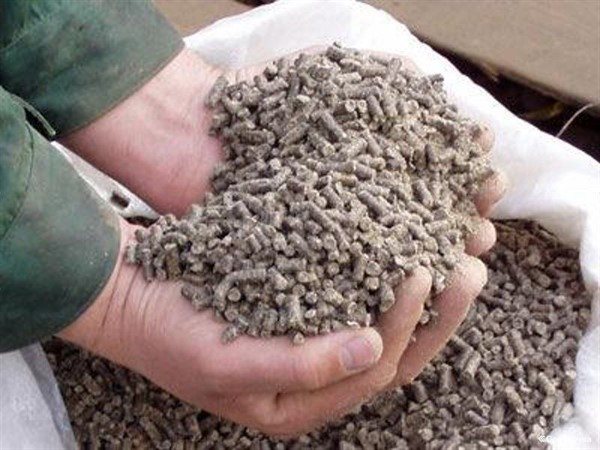

After that, the cereals enter the drum and grind to a flour consistency. The flour enters the press, equipped with a heating element, where the flour is “baked” to the required state. At the exit, he receives high quality feed. Forage productivity (FC) increased significantly.
KP increase before and after the extruder
Wheat:
- Natural forage productivity (CP 1) - 42%
- Feed productivity after the extruder (CP 2) - 93%
Barley:
- CP 1 - 30%
- CP 2 - 88%
Corn:
- CP 1 - 51%
- CP 2 - 98%
It becomes clear that the extruder will instantly pay off, thanks to the feed productivity.
The note! The compound feed made by the extruder is suitable for laying hens as well as for larger animals such as cattle, pigs, sheep or goats.
What is better - steam or dry food
It is never recommended to give dry compound feed to chickens and broilers. Many people ask themselves how to steam feed for broilers? The answer is very simple, for these types of birds it is better to use a 1: 1 ratio for each feed, depending on the manufacturer's recommendations.
It is important to understand that dry food is dangerous for poultry: a laying hen or broiler can simply choke if there is not enough water nearby.
To the question: how to properly steam mixed feed for chickens, you can answer with a similar answer - 1: 1. Initially, the manufacturer's recommendations must be taken into account. The amount of feed depends on the weight of the birds and their daily food intake. The physical condition of the bird is also important, if the layers are ready for the production of eggs, then the feeding should be intensive. Broilers need more intensive nutrition, because their weight reaches several times higher than the weight of ordinary chickens. It is recommended to feed the bird, taking into account the manufacturer's recommendations. Consideration should be given to weight and physical condition.


Compound feed, which is a dry mixture based on crushed grain with additional additives, is produced for most domestic animals: from poultry to cattle. And since proper feeding is a guarantee of not only a long life expectancy, but also productivity, the question of how to give animal feed - dry or steaming it, remains extremely relevant for most farmers.
is it possible to steam feed
I often steam mixed fodder for chickens and turkeys, but yesterday my uncle did not come, who scolded me for this, and says that this should not be done. Tell me if it is possible to steam feed
It is impossible to steam the compound feed for many reasons. Firstly, not eaten raw feed can sour, which will lead to diarrhea in the bird, and sometimes even to its death. Secondly, when steaming and boiling compound feed, valuable substances are destroyed in it, which are necessary for the normal growth and vital activity of the bird. And, thirdly, feeding with wet compound feed leads to the fact that its residues form dirt in the bird's cages.
I fundamentally disagree with you. Uncle was right, you can't steam feed!
when steaming, all valuable substances are lost. We are now buying ready-made compound feed, and that for chickens, that for chickens, that for ducks. We give everyone dry, but so that there is always water! And rabbits and cattle. all just dry.
And yet, even if you are making your own food (grinding), then you do not need to steam it either, of course the food is already rougher here, then you just need to fill it with warm, not hot, but warm water for swelling, of course this is done in advance, and not in 5 minutes before feeding. Again, why not hot, the value is lost!
And as your uncle explained to you that they cannot be steamed. The compound feed should be steamed. So it is better absorbed by the animal and its pain is eaten. I just did not see that chickens and turkeys were fed with compound feed. Usually it is given to rabbits, pigs, sometimes to rams.And the bird is fed with grain and herbs. What kind of compound feed do you use?
The effect of compound feed on the body of chickens
Chickens are happy to eat compound feed, if it is correctly selected. It is selected taking into account the age of the bird, its purpose. A scientific approach is applied to its creation, taking into account all the necessary factors for a good nutrition of the bird.
Benefit
- The benefits of a compound feed ration can be described as follows:
- food is balanced taking into account the needs of birds;
- the bird feels healthy;
- the feed contains the necessary minerals, vitamins;
- even a small amount of compound feed will saturate the bird;
- you can experiment with the composition, choosing the most acceptable;
- there is no need to feed pets with vegetables, grain, additives;
- the need to change the diet at different times of the year disappears;
- saving storage space.
Harm
- In some cases, compound feed can be harmful, namely:
- if the composition does not suit the bird;
- if it is of poor quality;
- if it contains harmful additives such as antibiotics, enzymes, dyes;
- if it contains too many vitamins and minerals, which can cause allergies;
- if the conditions of its storage are not observed.
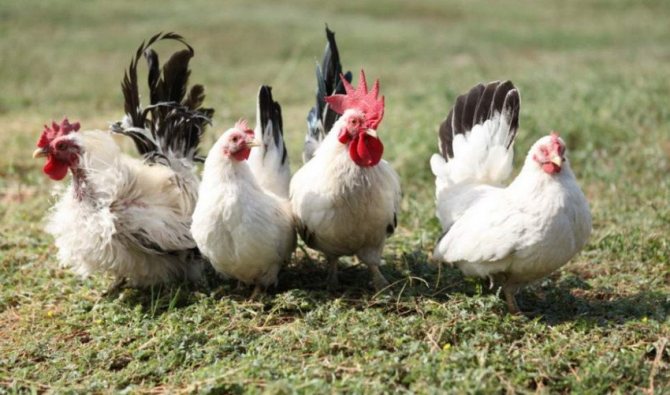

Pros and cons of using compound feed
Prepared rations for layers, when they are of adequate quality, are beneficial in that:
- contain all the products necessary for chickens, therefore they can be used as a complete and only feed;
- allow you to save time and effort of the poultry farmer;
- takes into account the peculiarities of the physiology of birds of different productive directions, age and sex;
- toxic safe;
- strengthens health;
- increases productivity.
The disadvantages include its high price, especially when compared with the cost of fodder crops grown in their own fields and gardens.
Vitamin Supplements
Vegetables will help improve the taste of feed and enrich it with vitamins. Most often, boiled potatoes are added to the mixture. It can be mixed with boiled or raw carrots, orange pumpkin and other fruits rich in carotene. In combination with oils, vegetables provide the body of chickens with vitamin A. In addition, bright fruits have a positive effect on the color of the yolk, making it rich orange.
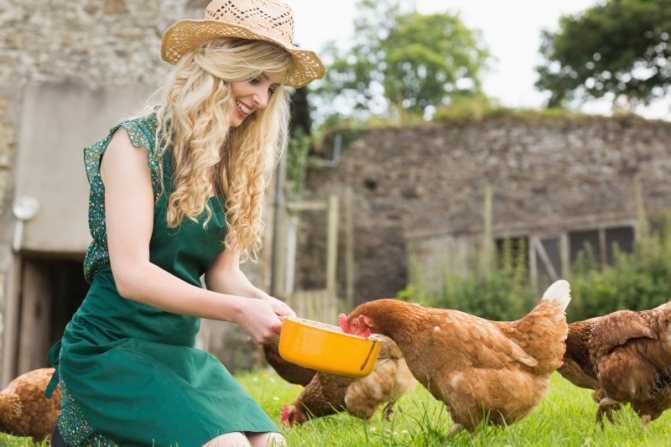

It is good to feed chickens with vegetables
Zucchini and cabbage can be added to the feed mixture: white cabbage, kohlrabi, broccoli, cauliflower. Sugar or fodder beets, apples, garden berries are suitable. An excellent nutritional supplement is carrot and beet tops, as well as lettuce and spinach. They love chickens and succulent weeds: wheatgrass, sedge, woodlice, plantain. The grass is cut into small pieces and poured into the feed just before serving. In the cold season, fresh grass is replaced by hay, hay dust or forage silage.
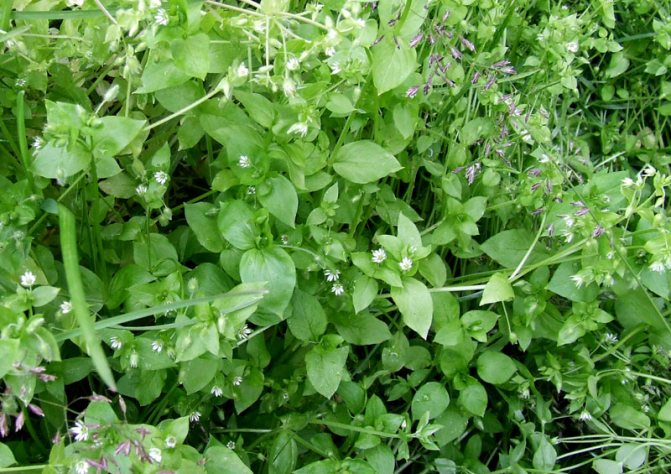

Woodlice is a favorite of poultry
Food waste can also be included in the compound feed: vegetable and fruit peelings, remnants of cereals and pasta, fish offal, bread and rusks, sour milk and cottage cheese. It is important not to overdo it, the waste is not nutritious and will not be able to meet the basic needs of the bird. Food additives must not be spoiled.
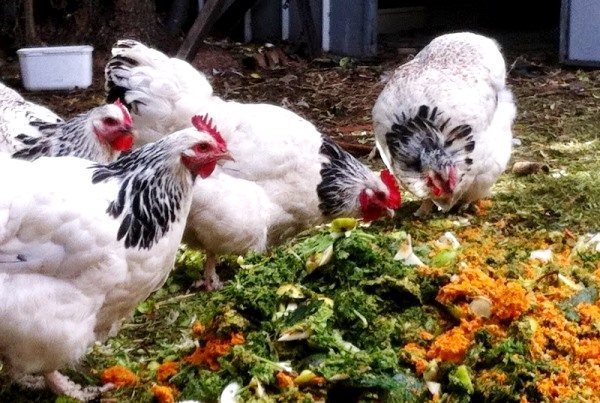

Vegetable waste for chicken feed
Many poultry farmers do not recommend giving chickens white bread, sweets and meat waste, arguing that an excess of such products can provoke health problems.

